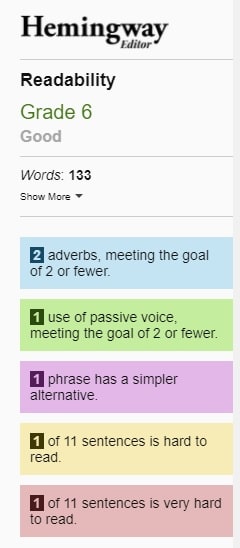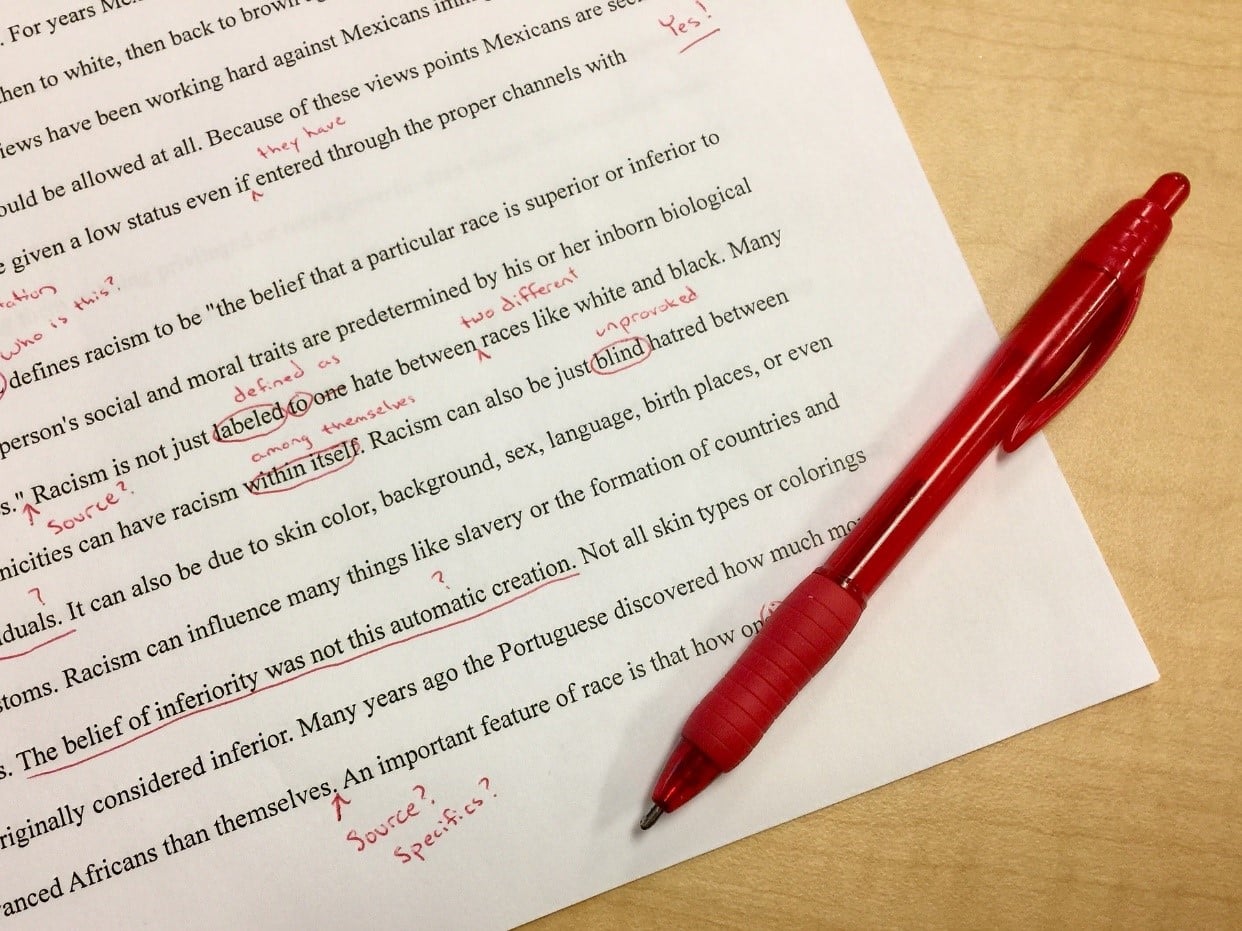5 Reasons Why Hiring a Professional Editor Is Better than Using Online Editing Tools
December 7, 2021
“The life of an editor is not a glamorous one. You’re a fixer; you make things better.” —Courtney B. Vance
Typically, most people think editors are folks who wield big, red pens. However, a professional editor is far more than someone who corrects written content.
An editor needs to dabble in mind-reading. For starters, an editor needs to glean what is in the writer’s mind and understand what the writer wishes to convey. This is necessary because the editor’s goal is to adequately transmit the writer’s message in the best possible manner.
Secondly, an editor must read the audience’s mind to understand the reader and what they expect to get from the text. Consequently, an editor must have one foot on each side of the writing equation.
That is certainly not an easy task.
With the advent of computer-aided tools, many writers and even publishers have increasingly turned to automated online editing tools. However, there’s no doubt that an old-school approach is more appropriate in professional editing.
All About Automated Online Editing Tools
Good editing requires a careful and deliberate process. After all, there is an evident reason why publishers hire professional editors. They have the necessary skills to sift through literary works to uncover any needs for improvement.

Contrary to popular belief, the job of an editor is not to simply “correct” mistakes.
Editors must interpret texts so they can ensure the content is clear and transmits the message it intends.
Generally speaking, an editor should be able to polish up a book.
Here is one way to think of it:
A master craftsman produces a beautiful table. The table goes into a showroom for customers to purchase. The sales staff polishes the table one last time before customers buy it.
This example underscores the need to make sure books are as neat as possible. Editors can catch minute details that may get past an author or beta readers (non-professional test readers who read a manuscript before publication).
However, the increasing trend toward automation has naturally crept its way into the literary field. The case for automated editing tools lies in their simplicity and efficiency. After all, using automated online editing tools can seamlessly “replace” an editor– or so some might believe.
Automated tools cost a fraction of what an editor would charge. Most online tools offer a free basic subscription. Extra features can be obtained with premium packages which cost more depending on the application.
The NY Book Editors group offers this insight into what an automated editing tool can provide:
“This type of tool proofreads your writing, checking for grammar, spelling, and a host of other errors. While your text editor will probably have built in spelling and maybe a grammar check, a dedicated editing tool can find hidden errors that are easily missed on a standard text editor.”
This statement encapsulates the purpose of an automated editing tool. Consequently, automated tools are a great way to catch spelling, grammatical, and some relatively basic style errors.
However, the NY Book Editors also drop this small dose of truth: “Remember that no automatic editing tool can ever take the place of a human.”
Indeed, there is no way to replace a human editor. There is a reason why publishers still hire professional editors. They can check for style, voice, and messaging in the writing. They can determine the appropriate tone for the subject matter.
Moreover, professional editors can intuit what readers want to get out of the text.
These services are things no automated editing tool can do.
Nevertheless, there is no reason to dismiss automatic online editing tools entirely. These tools can drastically facilitate the editing process and provide further support to the author.
As such, it is worth taking a look at the most popular text editing tools on the market.
The Most Popular Automated Online Editing Tools
Cyberspace contains various automated online editing tools. With such an array of options, choosing the right one might be somewhat confusing.
To help you make the decision, we have compiled a list of the most popular online editing tools available, focusing on their pros and cons.
Grammarly
Grammarly has taken the automated editing market by storm. This app has quickly become a fan favorite across the board. This is because Grammarly is quite comprehensive, even with its free version.
Basically, Grammarly is a turbo-charged proofreading tool. It can capture spelling, grammar, subject-verb agreement, and clarity errors.
Its artificial intelligence (AI) engine can adapt to various writing styles. For instance, its AI can check text using an academic approach.
Other settings include business, casual, and creative. The main difference lies in how strictly the writing adheres to convention (academic, business, casual, or creative styles). For example, the academic setting will strictly enforce all grammatical and style conventions such as contractions, personal pronouns, and passive voice.

Another of Grammarly’s interesting features is its word choice and sentence structure check. These features are part of the premium package. Nevertheless, they are worth the money for professional writers and editors.
The word choice feature provides suggestions on synonyms and related terms. This feature is useful, particularly when writers get in the habit of overusing a single term. The structure check offers helpful hints on improving clarity and removing “wordiness.” However, wordiness is a relative term as some authors prefer more complex sentence structures.
Grammarly offers suggestions on four specific areas: correctness (spelling or grammar), clarity (logic and coherence), engagement (engaging and interesting), and delivery (connotation or meaning of words). Correctness pertains to fundamental mistakes such as grammar and spelling. Clarity and engagement are not mistakes per se.
However, these suggestions may constitute mistakes depending on the degree of formality. For instance, the use of passive voice may not be suitable for formal writing. In contrast, the passive voice would be acceptable for informal writing. Furthermore, delivery focuses on style issues such as adverbs, adjectives, and word order such as prepositions ending a sentence.
Also, Grammarly offers various levels of formality. There are three levels: formal, neutral, and informal. These three levels determine how strictly the writing should adhere to writing conventions. The formal setting requires the strict observance of all related American English spelling, grammar, and style conventions.
Perhaps Grammarly’s best feature is checking text based on “audience.” There are three types of audiences: general, knowledgeable, and expert. Naturally, each type of audience sets Grammarly’s AI to sniff out terms that may be too infrequent for a general audience. By the same token, the AI may suggest more formal terms for common words and expressions.
On the whole, Grammarly is a wonderful tool. Many will find the paid subscription is worth it, especially for writing and editing pros.
However, Grammarly is not perfect. Its AI tends to confuse terms from time to time. For instance, Grammarly’s AI may not recognize technical or legal terms. Additionally, text that makes consistent use of a specific term trigger constant suggestions for synonyms. But there are times when synonyms do not make sense within the material’s context.
The good news is that Grammarly’s AI continues to improve as writers and editors feed its engine. Nonetheless, writers and editors must be wary of accepting suggestions on auto-pilot. Grammarly is not perfect and thereby requires attention when editing texts. Grammarly easily installs onto Microsoft Word as an add-on and it easily facilitates editing for those working directly in Word.
Hemingway
Named after the Nobel laureate, Hemingway is a no-nonsense online editing app.
Its most interesting feature is its color-coded system.
Essentially, Hemingway identifies various types of errors by highlighting them with different color schemes.
For instance, blue indicates adverbs, green is passive voice, purple points out simpler phrases, yellow shows hard to read sentences, and red points out very hard to read sentences.
Hemingway’s main purpose is to encourage simplified writing. Therefore, its suggestions aim to make writing short and sweet. Mainly, this app looks to reduce the use of adverbs and wordiness as much as possible.
Hemingway also assigns a grade level for texts. Thus, writers and editors can assess the reading difficulty of their materials. This feature enables writers and editors to simplify or increase the complexity of their texts to meet their target grade-level reading.
One of the great things about Hemingway is that it is also free. Anyone can use it directly from its website. A relatively recent desktop app has also been created.

The verdict on Hemingway is that it is a good app for shorter pieces of content. Texts around 1,000 to 2,000 words work very well with Hemingway. But the app is less suitable for full-length book manuscripts. Nevertheless, blog posts, articles, or shorter materials work very well with it.
CorrectEnglish
CorrectEnglish is essentially a proofreading app. It works very well by sifting through texts for grammar and spelling errors. Also, it helps with readability and overall flow. However, this app is not capable of full-fledged editorial work. As a result, authors and editors should proofread a text before conducting a deep and detailed read.
AutoCrit
AutoCrit is specifically made for fiction writers. It aims to reduce redundancy, passive voice, filler words, and adverbswith a goal of improving overall pacing and dialog. It is very good for weeding out common writing mistakes. These features make AutoCrit great for authors looking to clean up a manuscript. The app carries a $5 monthly fee.
WordRake
WordRake is a great proofreader. It works in tandem with Microsoft Word. Specifically, this editor seeks to reduce confusing prose by avoiding redundancies and highlighting mistakes such as subject-verb agreements, incorrect tense use, and misspelled words. It is great for tightening up texts. WordRake is quite popular with lawyers and students. However, there is one major drawback. WordRake does not do a deep dive with grammar and spelling. Therefore, users may need to rely more on Word’s built-in spellcheck capabilities to cover these areas.
When to Hire a Professional Editor
Automated editors are wonderful tools to have. They can facilitate the proofreading process by doing most of the heavy lifting. However, the truth is that there is just no substitute for a human editor.
Indeed, there limitations to what automated tools can achieve. And there are times when the best option is to hire a professional editor.
As such, here are five specific areas where hiring a professional editor is better than only relying on automated editing software.
1. Developmental Editing
At its essence, a developmental edit is a “significant structuring or restructuring of a manuscript’s discourse.” In other words, a developmental edit looks at a manuscript’s structure, whether or not the text accomplishes its purpose, and if there are any missing pieces.

A good developmental edit requires using an experienced editor familiar with the subject matter.
The result should be an editorial assessment that publishers and authors can use to improve a manuscript’s quality. In some cases, the recommendations from an editorial assessment may lead to significant rewrites.
This type of assessment is suitable at all stages of the writing process. But developmental edits are best for finished and proofread manuscripts undergoing the initial editing process.
2. Fact-Checking
In the non-fiction domain, some editors specialize in fact-checking.
Specifically, fact-checking ensures that the information, claims, and advice presented in the material is accurate. Furthermore, fact-checking helps writers avoid using misleading or partially true information. Naturally, authors and publishers must ensure accuracy to avoid legal consequences.

Also, fact-checking is an essential task that automated editors cannot carry out. After all, AI has yet to reach a point where it can differentiate between fact and fiction. Professional editors have the ability to cross-reference information to ensure they are on the right track.
3. Quality Assurance
Author Copilot founder J. Thorn believes “…an editor should be hired when the author believes the manuscript is as good as it can be.”

A professional editor plays a crucial role in quality assurance. After all, authors do not always have an objective opinion about their work.
Even when authors receive honest and constructive third-party criticism, an editor provides an impartial opinion on the manuscript’s overall quality.
Please bear in mind that this quality assurance role should not involve proofreading. Grammarly (or a professional proofreader) can take care of that.
A professional editor’s quality assurance role should focus on honestly assessing “big picture” items. In other words, a professional editor must ensure the manuscript’s cohesion, logic, and narrative.
4. An Expert Opinion
Publishers often take a professional editor’s opinion at face value.
Why?
Professional editors are seasoned veterans who can distinguish between a good manuscript and a subpar one.
Hiring a professional editor gives authors an expert opinion on their work. Professional editors know what makes good writing, and can help authors improve their manuscripts.
Authors and publishers should hire a seasoned editor to provide an unbiased appraisal. Editors can help writers refine their work and create the best possible manuscript.

When authors or publishers neglect to get an editor’s opinion, they are unlikely to publish the best possible version of the work. The publication may fail to deliver on expectations.
5. The Human Touch
There is one thing that AI will never be able to deliver: the human touch.

Automated tools may be great at sifting through the linguistic minutiae. However, automated tools do not have the human intuition that great writing requires.
Words can trigger emotions. Great prose can create images in a person’s mind as imagination soars. Only humans are capable of determining the impact of wonderful writing. Only a professional human editor can assess how effectively a literary piece is able to produce feelings in the reader.
At the end of the day, a professional editor provides insight that no machine can deliver. Perhaps technology may be able to supplant a human editor at some point. For now, the human touch will always be an important component of all great writing.
The Final Verdict
The debate between automated editing tools and professional human editors should focus on combining both approaches.
Automated editing tools greatly facilitate the proofreading process. These tools save time, allowing editors to focus on the most important aspects of the editing process.
Consequently, authors, editors, and publishers could consider adding automated online editing software as another arrow in their quivers.
It may be that AI will never be able to replace the human touch. Professional editors will likely always have a place in the literary world.
The decision to hire a professional writer ultimately boils down to wanting to produce the best possible manuscript. Automated editing tools can help make that aim easier to accomplish.































